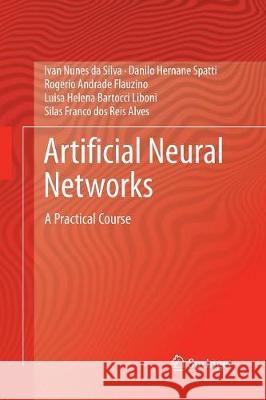Artificial Neural Networks: A Practical Course » książka



Artificial Neural Networks: A Practical Course
ISBN-13: 9783319827513 / Angielski / Miękka / 2018 / 307 str.
Artificial Neural Networks: A Practical Course
ISBN-13: 9783319827513 / Angielski / Miękka / 2018 / 307 str.
(netto: 345,83 VAT: 5%)
Najniższa cena z 30 dni: 346,96
ok. 22 dni roboczych
Dostawa w 2026 r.
Darmowa dostawa!
"The book under review is quite unique, covering many important topics usually omitted from introductory courses on artificial neural networks, and as such it is a valuable reference. ... A major advantage of this volume is the interesting choice of examples used, most of which are not commonly considered in the artificial neural network literature." (Sandro Skansi, Mathematical Reviews, April, 2018)
"This book would be very good for advanced undergraduate students, first-year graduate students, or for anyone wishing to learn about neural networks on their own. It was originally published in Brazil in Portuguese. ... The exercises thoroughly test the readers' understanding of the descriptive material. The practical examples address the training and use of the architecture in the chapter." (Anthony J. Duben, Computing Reviews, April, 2017)
Introduction.- PART I – Neural Networks Architectures and Their Theoretical Aspects.- Architectures of Artificial Neural Networks and Training Processes.- Perceptron Network and Learning Rule.- Adaline Network and Delta Rule.- Multilayer Perceptron (MLP).- Radial Basis Function (RBF).- Recurrent Neural Topologies and Hopfield Network.- Self-Organizing Maps and Kohonen Network.- Learning Vector Quantization (LVQ) and Counter-Propagation Network.- Adaptive Resonance Theory (ART).- Part II – Artificial Neural Networks Applications in Problems of Engineering and Applied Sciences.- Coffee Global Quality Estimation Using Multilayer Perceptron.- Computer Network Traffic Analysis Using SNMP Protocol and LVQ Network.- Forecasting Stock Market Trends Using Recurrent Network.- System for Disease Diagnosis Using ART Network.- Adulterants Patterns Identification in Coffee Powder Using Self-Organizing Maps.- Disturbances Recognition Related to Electrical Power Quality Using PMC Network.- Mobile Robot Trajectory Control Using Fuzzy System and MLP Network.- Method to Tomatoes Classification Using Computer Vision and MLP Network.- Analysis of RBF and MLP Network Performance in Pattern Classification Problems.- Solving Constrained Optimization Problems Using Hopfield Network.- Conclusion.
IVAN NUNES DA SILVA was born in São José do Rio Preto, Brazil, in 1967. He graduated in computer science and electrical engineering at the Federal University of Uberlândia, Brazil, in 1991 and 1992, respectively. He received both M.Sc. and Ph.D. degrees in electrical engineering from the State University of Campinas (UNICAMP), Brazil, in 1995 and 1997, respectively. Currently, he is an Associate Professor at the University of São Paulo (USP). His research interests are within the fields of artificial neural networks, fuzzy inference systems, power system automation and robotics. He is also associate editor of the International Journal on Power System Optimization and Editor-in-Chief of the Journal of Control, Automation and Electrical Systems. He has published more than 400 papers in congress proceedings, international journals and book chapters.
DANILO HERNANE SPATTI was born in Araras, Brazil, in 1981. He graduated in electrical engineering from the São Paulo State University (UNESP), Brazil, in 2005. He received both M.Sc. and Ph.D. degrees in electrical engineering from the University of São Paulo (USP), Brazil, in 2007 and 2009, respectively. Currently, he is a Senior Researcher at the University of São Paulo. His research interests are artificial neural networks, computation complexity, systems optimization and intelligent systems.
ROGÉRIO ANDRADE FLAUZINO was born in Franca, Brazil, in 1978. He graduated in electrical engineering and also received M.Sc. degree in electrical engineering from the São Paulo State University (UNESP), Brazil, in 2001 and 2004, respectively. He received Ph.D. degree in electrical engineering from the University of São Paulo (USP), Brazil, in 2007. Currently, he is an Associate Professor at the University of São Paulo. His research interests are artificial neural networks, computational intelligence, fuzzy inference systems and power systems.
SILAS FRANCO DOS REIS ALVES was born in Marília, Brazil, in 1987. He graduated in information systems from the São Paulo State University (UNESP). He received M.Sc. degree in mechanical engineering from the State University of Campinas (UNICAMP) and Ph.D. degree in electrical engineering from the University of São Paulo (USP), Brazil, in 2011 and 2016, respectively. Currently, he is a Senior Researcher at the University of São Paulo. His research interests are robotics, artificial neural networks, machine learning, intelligent systems, signal processing and nonlinear optimization.
LUISA HELENA BARTOCCI LIBONI was born in Sertãozinho, Brazil, in 1986. She graduated in electrical engineering from the Polytechnic School of the University of São Paulo (USP), Brazil, in 2010. She received Ph.D. degree in electrical engineering from the University of São Paulo (USP), Brazil, in 2016. Currently, she is a Senior Researcher at the University of São Paulo. Her research interests are artificial neural networks, intelligent systems, signal processing and nonlinear optimization.
This book provides comprehensive coverage of neural networks, their evolution, their structure, the problems they can solve, and their applications. The first half of the book looks at theoretical investigations on artificial neural networks and addresses the key architectures that are capable of implementation in various application scenarios. The second half is designed specifically for the production of solutions using artificial neural networks to solve practical problems arising from different areas of knowledge. It also describes the various implementation details that were taken into account to achieve the reported results. These aspects contribute to the maturation and improvement of experimental techniques to specify the neural network architecture that is most appropriate for a particular application scope. The book is appropriate for students in graduate and upper undergraduate courses in addition to researchers and professionals.
1997-2025 DolnySlask.com Agencja Internetowa
KrainaKsiazek.PL - Księgarnia Internetowa









